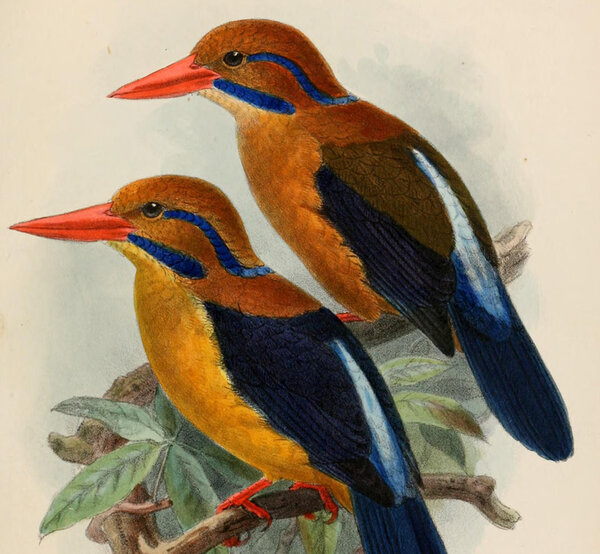I have now lost count of the number of forwarded copies of the
“A scientist found a bird that hadn’t been seen in half a century, then killed it”
mail that people have sent me. The collection of a Bougainville
Moustached Kingfisher specimen by an AMNH team in Guadalcanal has
drawn intense criticism and reignited the debate about whether
scientific collection is justified or even necessary.
 [Illustration: J G Keulemans (1842–1912),
Novitates Zoologicae]
[Illustration: J G Keulemans (1842–1912),
Novitates Zoologicae]
I don't have anything new or insightful to add to this debate.
As a bird-watcher, of course I prefer live birds to dead ones, so I
appreciate and can relate to the passion with which many have argued
that we should, above all, do no harm, and that we should be working
harder than ever to keep them alive.
As a realist, I must admit that most of what I know about live birds
comes in one way or another from dead ones (and the people who killed
them), perhaps especially from ones that died long before the ethics of
collecting specimens were debated at all.
I am not a conservationist or a biologist, and I have to live with this
uneasy equilibrium, lacking enough perspective to pick one side and
stick with it, and certainly not knowing enough about any specific
incident to either condemn or condone it.
I do know a thing or two about data, however, and I've heard suggestions
that we can take some definitive set of measurements from a live bird in
lieu of a specimen—or that we should at least be working to develop such
an ability—and that once we have it, we won't need specimens any more.
I think we're far from being able to take a complete “snapshot” of a
bird good enough to consider as a primary source of data about a new
species, but of course we can improve the nature and quantity of
information that can be collected from live birds without causing much
distress, and I'm sure that would be good news for everyone.
For any given research topic, one could imagine a set of observations
that would answer the question without a specimen. For example, the
oft-cited research that established a link between DDT and a thinning of
egg shells in various raptors could have been done if the eggs had been
measured and their thickness recorded at various points in some
non-destructive manner.
But at any given time, there will always be some measurements we can't
take and questions we can't imagine. In representing a live bird as
data, we will always be limited by the current state of the art. Unless
we never ask new questions or improve our instruments of measurement, we
will always lose something in the summarisation. (Some information is
lost even in the current specimen preservation process. I don't think
we're in a position to research, say, trends in the heart size of
raptors over time.)
We can choose to forego the preservation of a type specimen,
and perhaps in future our snapshots will improve to a point where this
decision becomes easier, but it will always involve a compromise one way
or another.
(Please ignore this link if you don't know what git is)
Aside: This dichotomy reminds me of a fundamental design
principle in Git, which differs from most other version control systems
in storing a complete tree of files for every commit, rather than a
summary of the differences from the previous commit. This decision
enabled features like rename detection across merges to be improved
progressively without changing the data format, because the detection is
always done using state-of-the-art code against the complete, canonical
data, rather than relying on decisions taken by older code with less
context available.